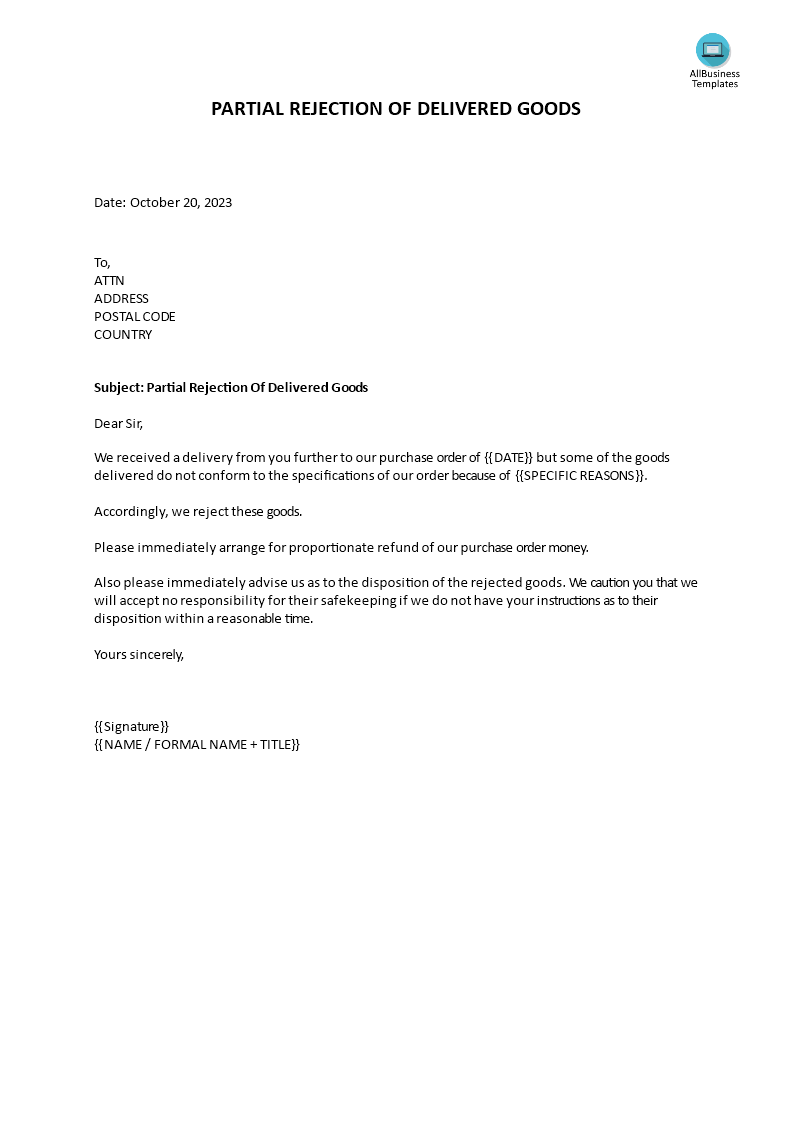Partial Rejection Of Delivered Goods
Save, fill-In The Blanks, Print, Done!

Download Partial Rejection Of Delivered Goods
Today: USD 2.99
Download It Now

Available premium file formats:
Microsoft Word (.docx)- This Document Has Been Certified by a Professional
- 100% customizable
- This is a digital download (23.71 kB)
- Language: English
- You will receive a link to download the file as soon as your payment goes through.
- We recommend downloading this file onto your computer.
Do you need a
Partial Rejection Of Delivered Goods? Why are goods rejected when they are delivered? Get our partial rejection of delivered goods template is perfect for any business that receives goods from suppliers. It includes all the necessary information to accurately document the rejection. It can be downloaded and use so easily.
Partial rejection of delivered goods refers to a situation in which a recipient, typically a buyer or customer, accepts only a portion of the goods that have been delivered by a supplier or vendor while rejecting the remaining portion. This action is taken when the recipient identifies issues or discrepancies with some of the delivered goods but still wants to accept those that meet their requirements or standards. Partial rejection is a way to address and resolve issues with a shipment without entirely refusing the entire delivery.
Here are some common scenarios in which a partial rejection of delivered goods may occur:
- Quality Issues: The recipient may find that some of the delivered items are damaged, defective, or do not meet the quality standards specified in the purchase agreement or contract. In this case, they may choose to reject the subpar items while accepting those in acceptable condition.
- Quantity Discrepancies: If there are discrepancies in the quantity of goods delivered compared to what was ordered or agreed upon, the recipient may accept the correct quantity and reject the excess or shortage.
- Wrong Items Delivered: Sometimes, the supplier may have delivered items that are different from what was ordered. In such cases, the recipient may accept the correct items and reject the incorrect ones.
- Partial Fulfillment: When a supplier is unable to fulfill the entire order due to inventory shortages or production issues, the recipient may choose to accept what is available and reject the remainder.
- Inspection: The recipient thoroughly inspects the delivered goods to identify any issues, discrepancies, or defects.
- Documentation: The issues or discrepancies are documented in writing, along with clear evidence such as photographs, descriptions, or counts of affected items.
- Notification: The recipient promptly notifies the supplier or vendor of the partial rejection, specifying the reasons and providing supporting documentation.
- Resolution: The parties involved negotiate and agree on how to resolve the partial rejection. This may involve arranging for replacements, refunds, or credits for the rejected items while retaining the accepted portion.
- Return or Disposal: If necessary, the rejected items may be returned to the supplier or disposed of according to mutually agreed-upon terms.
- Payment Adjustment: In cases where partial payment has already been made, adjustments are made to the payment to account for the value of the rejected goods.
A well-documented and clear communication process is essential when handling partial rejections to ensure that both parties understand their rights and responsibilities. The terms and conditions regarding partial rejections and dispute resolution are often outlined in purchase agreements or contracts between the buyer and supplier.
Download this professional
Partial Rejection Of Delivered Goods template now!
For more business templates? Just browse
through our database and website! You will have instant access to thousands of
free and premium business templates, legal agreements, documents, forms,
letters, reports, plans, resumes, etc., which are all used by professionals in
your industry. All business templates are ready-made, easy to find, wisely
structured, and intuitive.
DISCLAIMER
Nothing on this site shall be considered legal advice and no attorney-client relationship is established.
Leave a Reply. If you have any questions or remarks, feel free to post them below.
Related templates
Latest templates
Latest topics
- Excel Templates
Where do I find templates for Excel? How do I create a template in Excel? Check these editable and printable Excel Templates and download them directly! - GDPR Compliance Templates
What do you need to become GDPR compliant? Are you looking for useful GDPR document templates to make you compliant? All these compliance documents will be available to download instantly... - Google Docs Templates
How to create documents in Google Docs? We provide Google Docs compatible template and these are the reasons why it's useful to work with Google Docs... - IT Security Standards Kit
What are IT Security Standards? Check out our collection of this newly updated IT Security Kit Standard templates, including policies, controls, processes, checklists, procedures and other documents. - Letter Format
How to format a letter? Here is a brief overview of common letter formats and templates in USA and UK and get inspirited immediately!
cheese
